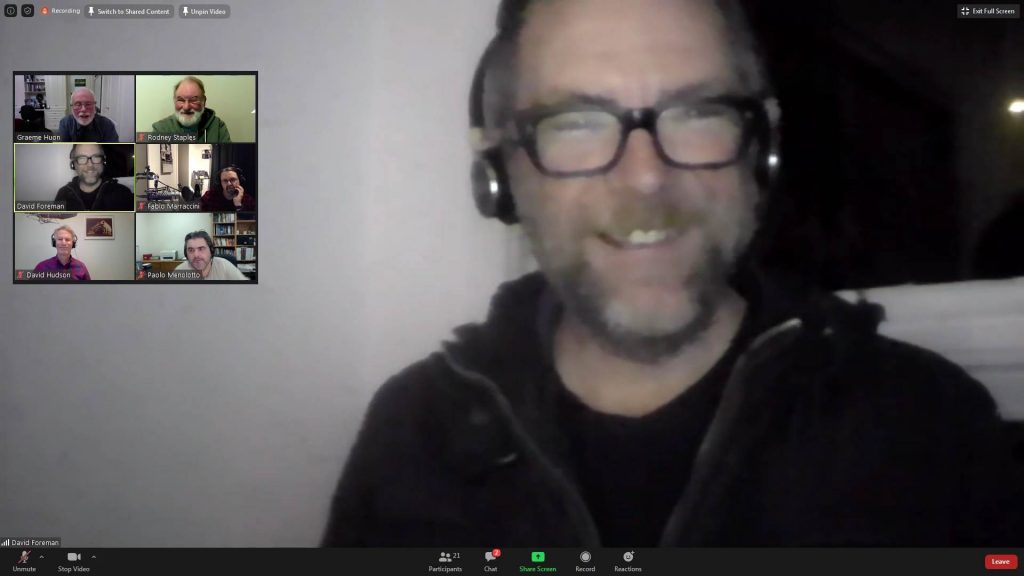The Melbourne Section conducted our first online meeting under the current lockdown conditions on Monday May 18th using the Zoom platform.
Our guest speaker was David Foreman, National Lead for Audio Visual Specialists and Installed Solutions at Sonos Australia.
Chairman Graeme Huon welcomed the 20+ attendees and introduced our speaker to present to us on his topic – Sonos – A History of Innovation and Collaboration.

David started by introducing us to Sonos, its mission and pillars, and went on to describe the Sonos system as an internet-connected sound system that uses Wi-Fi to stream audio through any or every room in the home. He characterised it as modular and scalable, and went on to describe their three product categories: all-in-ones, home theatre, and architectural. He covered the way the devices can be used to access locally stored or online content (music, podcasts, audio books etc), all controlled via many interfaces: touch controls, the Sonos smartphone app, partner apps (Spotify, Tidal etc), voice control, and via partner platforms (Control 4, Crestron etc).
After a brief overview of the range of music and spoken voice services available to Sonos devices, David went on to describe the Wi-Fi and wired networking options available.
After describing the range of speakers and home theatre systems available, David went on to cover the Operating System. He described how the software platform has just been completely overhauled, and the new OS to be released in June will support Dolby Atmos and enable faster innovation.
He then introduced us to the new products to be released in June 2020, the Sonos Arc soundbar, the Sonos 5 (an updated version of the popular Play:5), and the Sonos Sub Gen3 (an updated version of their award-winning Sub); walking us through the features and technical intricacies of each. He played particular attention to the soundbar, with its phased speaker arrays, ability to expand for surround sound, offering speech enhancement for clear dialogue, and Night Sound which reduces dynamic range to enable the listener to set the dialogue and lower level sounds at an intelligible level without having the peak sounds at a level that would annoy the neighbours (or family).
David then moved on to outline the history of Sonos, describing the company’s birth as a way to meet the founders’ personal need for a way to access their music. He outlined their background in establishing the site software.com in the early days of the Internet, and presented a timeline describing the original products and features from the first ZP100 hardware to the present product range.
He spent some time describing the design of the Sonos Amp which allows the use of external passive speakers and fits a 125W/Chan stereo amp with analog/digital inputs as well as full Sonos integration into a very small package, and then described Port which adds both analog inputs to a Sonos ecosystem, and Sonos functionality to existing analog audio systems.
David then described the Trueplay smartphone application (iOS only) which permits the tuning of a Sonos system’s response using the smartphone measurement and adjustment tool. In response to a question at the end of the session, he explained that the reason the app was exclusively iOS was that the Apple devices microphones were of a high quality and consistency across all iPhone and iPad models, whereas the Android ecosystem was too varied for sufficiently repeatable and accurate results.
He then mentioned the recording industry figures who were assisting Sonos in achieving a high quality sound in their products. Names like producers Rick Rubin and Giles Martin, Mastering Engineer Emily Lazar and Mixing Engineer Manny Marroquin.
David then mentioned the work done by composer Philip Glass on creating a signature sound (sonic branding) for Sonos, and finally introduced us to Sonos Radio a service for Sonos owners with curated playlists by leading artists across a range of genres.
Throughout the presentation the audience was able to submit questions via Zoom’s Chat function, and at the end of David’s presentation Graeme moderated a wide-ranging question and answer session.
Links:
Sonos blog article on creator collaborations:
https://blog.sonos.com/en/sonos-sound-experience-creators/
Sonos blog article on the sonic branding by Philip Glass:
https://blog.sonos.com/en/sonic-branding-by-philip-glass/
Thanks to David for a most informative session, and to Sonos Australia for their provision of the Zoom videoconferencing session.
